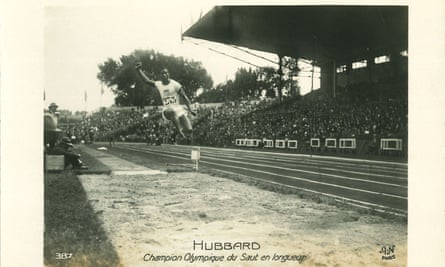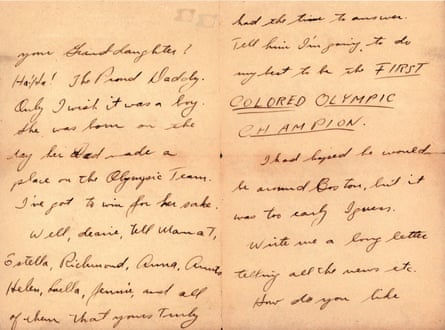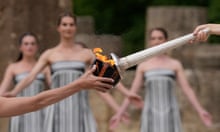For many people, the 1924 Paris Olympics will – thanks to the 1981 film Chariots of Fire – always be associated with slow-motion images of British runners beating the Americans against the odds, while Vangelis’s haunting score plays in the background.
But an exhibition at the Fitzwilliam Museum in Cambridge, timed to coincide with the event’s return to the French capital, aims to show that the Parisian games a century ago were a turning point, not just for British athletics, but also for race, politics and the rise of celebrity.
One of the main attractions at Paris 1924: Sport, Art and the Body is a letter written by the American long-jumper William DeHart Hubbard – the first black athlete to win an individual gold medal at an Olympics – which will be coming to the UK for the first time when the show opens on 19 July.

An actor playing Hubbard appears briefly in Hugh Hudson’s 1981 Oscar-winning film, but his prophetic letter, sent from the SS America and written just an hour before he set sail, adds to the mythos around an athlete who manifested his own landmark victory.
“At last I am ready to depart for Europe. It has taken years of hard work to get this far, but I am nearing my ultimate goal. The boat leaves in about an hour,” he wrote.
“Tell Papa I got his letter, but have been busy travelling etc., and have not had the time to answer. Tell him I’m going to do my best to be the FIRST COLORED OLYMPIC CHAMPION.”
The word “COLORED” was underlined twice, signifying the importance of race at an event where only one black athlete had won a medal before. That came in 1908, when John Taylor was part of the successful American 1,600-metre relay team.

Professor Caroline Vout from the University of Cambridge, who co-curated the exhibition, said the letter gave a unique insight into the mind of an athlete who was venturing into the unknown. “The writing of the letter is almost like an exercise of pumping himself up; it’s a spur. It’s all about exhilaration,” she said.
Vout added that despite his achievements, Hubbard and the other black athletes who took part in the games did not go on to stardom as some Olympians did.
American swimmer Johnny Weissmuller was a star at the games, winning gold in the 100m freestyle, 400m freestyle and 4 x 200m freestyle relay before going on to a Hollywood career, where he played the lead in six Tarzan films.
The story of British runners Harold Abrahams and Eric Liddell was immortalised in Chariots of Fire, while Hawaiian Duke Kahanamoku – who competed in the 100m freestyle alongside Weissmuller – was eventually recognised as the man who popularised surfing.
Co-curator Professor Christopher Young said that part of the reason Hubbard had been overlooked was that when people talk about important Olympic tournaments highlighting racial issues, the Berlin event of 1936, where Jesse Owens dismantled Hitler’s claims of Aryan supremacy by winning four gold medals, and 1968, when sprinters Tommie Smith and John Carlos made black power salutes, take primacy.
But, he argued, the 1924 games were another key turning point. “There’s a whole trajectory here which is overshadowed by those big moments and shows like this can bring people back into the public eye.”
The museum has also managed to acquire on loan the football boots worn by José Andrade, who played for Uruguay when they went on to win the gold medal in the football competition, a feat that stunned the European nations and presaged the South Americans winning the first World Cup six years later.









